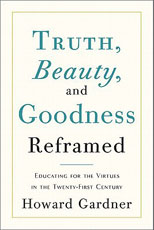"Enter the media. More than ever before, youth are now exposed to the potpourri of fads, fashions, and styles of living that have been adopted all over the world. A century ago, most young people saw with their own eyes the clothing, the houses, the media of their neighborhood, or possibly their nation — and nothing more. Their aesthetic sensibility was necessarily circumscribed and typically parochial. Nowadays, thanks to television, movies, and the web, billions of young people see for themselves and on their own the aesthetics of many other cultures. Watching MTV or surfing YouTube, they become aware of the numerous ways in which individuals can decorate themselves or one another, express themselves in line, color, story, or song; they are exposed, sometimes on an hourly basis, to the diverse aesthetics of a 'Silk Road' world. Indeed, the digital media present more options, more quickly, and in more ways than ever before. Canons of beauty, and of the arts more broadly, are destined to keep changing, and young persons can participate in bringing about these changes; no one — not biologist, not economist, not psychologist — can predict with any precision the ways in which they will change. Nor should we: When it comes to beauty, or to the arts, more generally, let innumerable flowers bloom, let ten thousand tastes emerge.
"At this historical moment, the reluctance to pass judgment, characteristic of postmodernism, joins forces with the instant digital accessibility of the global artistic landscape. And so there is a welcome opportunity to broaden the artistic horizons of young persons and to help them develop their own increasingly individualized senses of beauty.
"Let me introduce an idea that I find promising. Youth should be encouraged to keep a portfolio of artistic preferences. While such a portfolio could be kept in one's mind, it is far preferable for the portfolio to exist in tangible form: either through the collection of physical artifacts or, as a sign of the times, by means of digital files. Young people should be encouraged to place in that portfolio any artistic objects or experiences — made by famous artists, unknown artists, friends, or themselves — that they feel is worth preserving. In addition, they should be encouraged to record their own thoughts: what they like, what they value, and why. And they should pay special attention to changes of heart over time — what they no longer value as much, what they have come to value anew, and why.
"Ideally, the artistic portfolio should be shared with others — family, friends, and, when possible, adults knowledgeable in the arts. Teachers of the arts not only provide a useful sounding board; they may also be able to call attention to features that are less obvious to the youth. In this way, young persons will begin to solidify their own artistic identities, their own individualized senses of beauty. And consistent with the notion of identity as formulated by psychologists, this identity is defined in part by the way that the adolescent is (or is not) received within the broader community."
